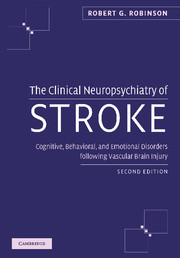 The Clinical Neuropsychiatry of Stroke
The Clinical Neuropsychiatry of Stroke Book contents
- Frontmatter
- Contents
- Preface
- Part I Introduction
- Part II Poststroke depression
- Part III Poststroke mania
- Part IV Poststroke anxiety disorders
- Part V Other poststroke disorders
- 34 Psychosis
- 35 Anosognosia and denial of illness
- 36 Catastrophic reaction
- 37 Apathy
- 38 Disturbance of prosody
- 39 Irritability and aggression
- 40 Pathological laughing and crying
- 41 Summary and future directions
- Index
41 - Summary and future directions
from Part V - Other poststroke disorders
Published online by Cambridge University Press: 01 October 2009
- Frontmatter
- Contents
- Preface
- Part I Introduction
- Part II Poststroke depression
- Part III Poststroke mania
- Part IV Poststroke anxiety disorders
- Part V Other poststroke disorders
- 34 Psychosis
- 35 Anosognosia and denial of illness
- 36 Catastrophic reaction
- 37 Apathy
- 38 Disturbance of prosody
- 39 Irritability and aggression
- 40 Pathological laughing and crying
- 41 Summary and future directions
- Index
Summary
In this second edition of The Clinical Neuropsychiatry of Stroke, I have attempted to review and summarize the world's literature on the many types of disorders which are a consequence of stroke. The only major group of mental disorders which was not discussed in detail is the cognitive disorders. Although much of our work has been devoted to examining the effect of depression, anxiety, mania, and other poststroke disorders on cognitive function, we have not systematically studied the neuropsychological impairments of specific lesion site or the syndrome of vascular dementia. In the absence of psychopathology, brain lesions themselves, of course, produce cognitive impairment. There are many texts of neuropsychology [e.g., Gazzaniga's Cognitive neuroscience (2002); Lezak's Neuropsychological Assessment (2004); Heilman's Clinical Neuropsychology (2003)] which discuss cognitive impairment in relationship to vascular infarction.
In addition to the wide variety of neuropsychiatric disorders which occur following stroke, perhaps the most striking aspect of our findings and the findings of other investigators is the high prevalence rate for many of these disorders. Table 41.1 provides a summary of all of the disorders discussed in this book including their prevalence, clinical symptoms, and associated neuropathology. As one reads down the column of prevalence of each of these disorders, it is obvious that the total is greater than 100%.
- Type
- Chapter
- Information
- The Clinical Neuropsychiatry of StrokeCognitive, Behavioral and Emotional Disorders following Vascular Brain Injury, pp. 447 - 454Publisher: Cambridge University PressPrint publication year: 2006


